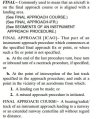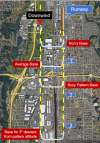dbahn
Pattern Altitude
Final is not defined with respect to distance in any FAA publication I could find. In fact, in the Pilot Controller Glossary (page 39) they specifically define it as "without regard to distance". I don't find any reference to a different definition for VFR.Define "final"? Quarter mile? Half mile? Ten miles? If someone calls in on a twenty-mile straight-in, does all other traffic yield to them?

And distance really doesn't matter. It's rate of closure that matters and that's always a judgment call. You just can't cut an aircraft off on final. I suspect the FAA interprets that to mean doing something that's "unsafe", and if the pilot on final has to go around I suspect that meets the definition. So no, you don't yield to anyone just because they're on final or if they simply announce something to that effect. You yield if it's unsafe to join the final in an unsafe manner. Hell, I can't even see an aircraft on a ten mile final, and even at 180 knots that's still about three minutes to intersecting a normal base leg.

